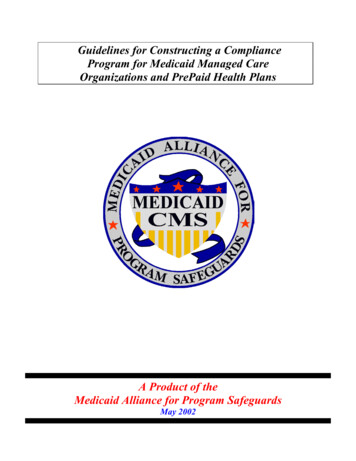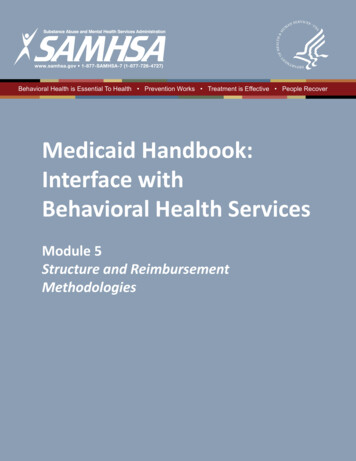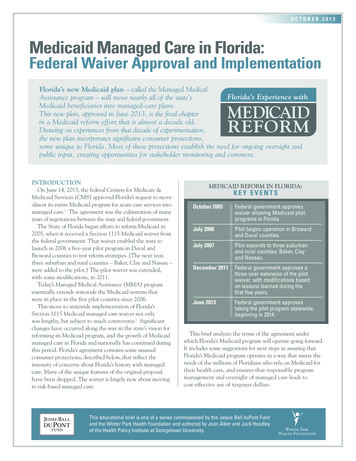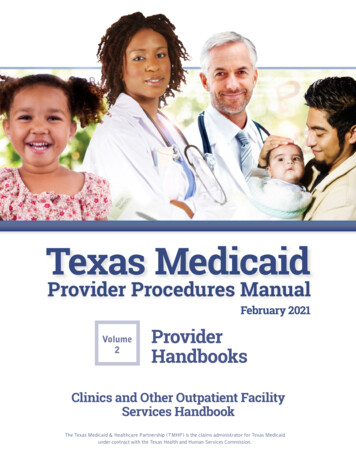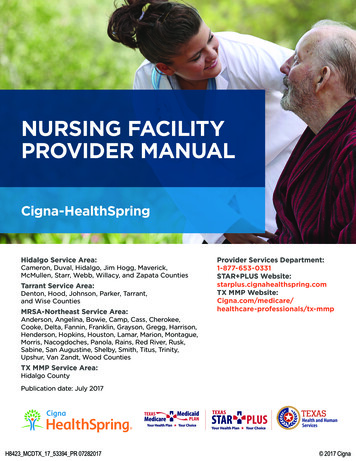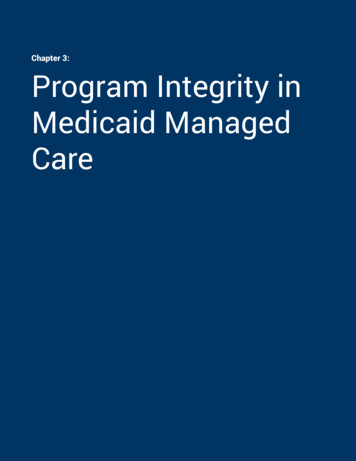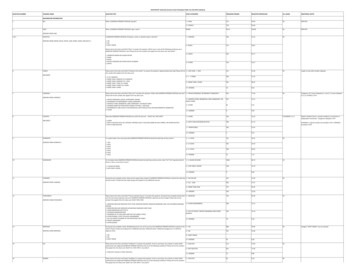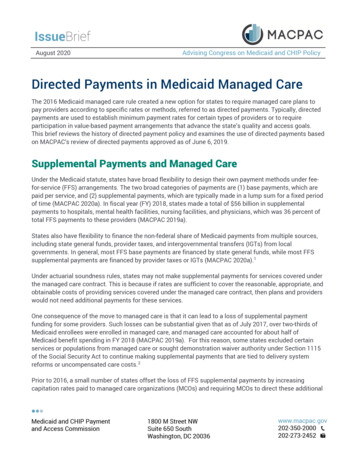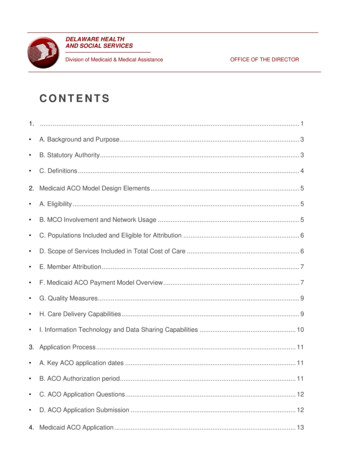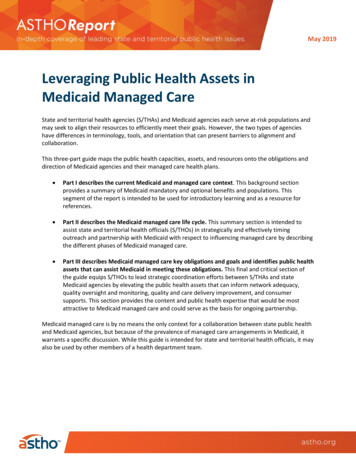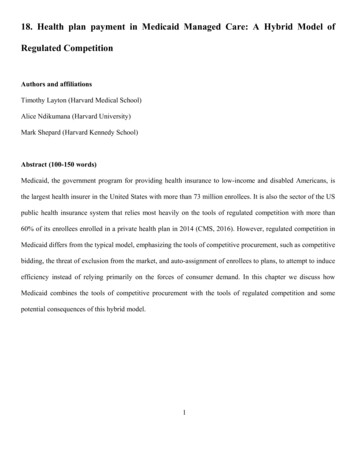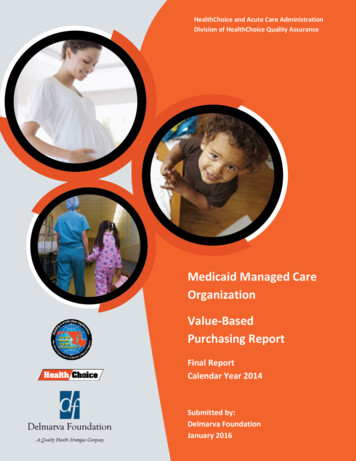
Transcription
HealthChoice and Acute Care AdministrationDivision of HealthChoice Quality AssuranceMedicaid Managed CareOrganizationValue-BasedPurchasing ReportFinal ReportCalendar Year 2014Submitted by:Delmarva FoundationJanuary 2016
Calendar Year 2014 Value-Based Purchasing ReportCalendar Year 2014Value-Based Purchasing ReportIntroductionValue-based purchasing (VBP) improves quality by awarding business and incentives to contractors based ontheir performance along a range of dimensions. The Maryland Department of Health and Mental Hygiene(DHMH) began working with the Center for Health Care Strategies in 1999 to develop a VBP initiative forHealthChoice, Maryland’s Medicaid managed care program. The goal of Maryland’s purchasing strategy is toachieve better enrollee health through improved managed care organization (MCO) performance.Appropriate service delivery is promoted by aligning MCO incentives with the provision of high-quality care,increased access, and administrative efficiency. Maryland’s purchasing strategy aims to better coordinate avariety of quality improvement efforts toward a shared set of priorities that focus on the core populationsserved by HealthChoice. In addition, the state’s strategy meets the requirements of the Federal BalancedBudget Act of 1997 (BBA).In compliance with the BBA, Maryland’s DHMH has contracted with Delmarva Foundation to serve as theExternal Quality Review Organization (EQRO) for HealthChoice. Among the functions that DelmarvaFoundation performs is the annual validation of performance measure data reported for the precedingcalendar year by the State of Maryland, its contractors, and the MCOs. Delmarva Foundation uses theCenters for Medicare & Medicaid Services (CMS’) protocols in validating VBP measure results.Delmarva Foundation and HealthcareData Company, LLC (HDC) validated the Calendar Year (CY) 2014VBP measurement data. DHMH contracted with HDC to perform the validation of HEDIS measures forthe HealthChoice MCOs. HDC performed the validation of the HEDIS -based VBP measurement data forthe eight HealthChoice MCOs using the National Committee for Quality Assurance’s HEDIS Volume 5:HEDIS Compliance Audit: Standards, Policies, and Procedures.Value-Based Purchasing ValidationSeveral sources of measures (Table 1) are included in the CY 2014 VBP program. They are chosen fromNCQA’s HEDIS data set, encounter data, and data supplied by the HealthChoice MCOs, and subsequentlyvalidated by Delmarva Foundation. The measure type and the presence of an existing audit or validationprocess determined the validation activities undertaken.Delmarva Foundation1
Calendar Year 2014 Value-Based Purchasing ReportTable 1. CY 2014 VBP MeasuresPerformance MeasureHEDIS DomainMeasureReportingEntityAdolescent Well CareUse of ServicesHEDIS MCOAdult BMI AssessmentEffectiveness of CareHEDIS MCOAmbulatory Care Services for SSI AdultsAccess to CareEncounter DataDHMHAmbulatory Care Services for SSI ChildrenAccess to CareEncounter DataDHMHBreast Cancer ScreeningEffectiveness of CareHEDIS MCOChildhood Immunization Status (Combo 3)Effectiveness of CareHEDIS MCOComprehensive Diabetes Care – HbA1 TestingEffectiveness of CareHEDIS MCOControlling High Blood PressureEffectiveness of CareHEDIS MCOImmunizations for Adolescents (Combo 1)Effectiveness of CareHEDIS MCOLead Screenings for Children Ages 12–23 MonthsEffectiveness of CareEncounter, LeadRegistry, & FeeFor Service DataDHMHMedication Management for People with AsthmaEffectiveness of CareHEDIS MCOPostpartum CareAccess to CareHEDIS MCOWell Child Visits for Children Ages 3–6Use of ServicesHEDIS MCOValidation MethodologyValidation is the process by which an independent entity evaluates the accuracy of reported performancemeasure data by or on behalf of another entity, and it determines the extent to which specific performancemeasures calculated by an entity (or one acting on behalf of another) followed established calculationspecifications. A validation (or audit) determination is assigned to each measure, indicating whether themeasure and its result is fully compliant, substantially compliant, or not valid.HEDIS Measure ValidationHealthChoice MCOs are required to produce and report audited HEDIS data under COMAR10.09.65.03.B(2). Ten of the CY 2014 VBP measures are HEDIS measures and are validated under theDelmarva Foundation2
Calendar Year 2014 Value-Based Purchasing Reportprovisions of the HEDIS Compliance Audit. The goal of the HEDIS audit is to ensure accurate, reliable,and publicly reportable data.The HEDIS Compliance Audit is conducted in three phases: offsite, onsite, and post onsite (reporting).The offsite audit phase includes a review of each MCO’s HEDIS Record of Administration, DataManagement and Processes (Roadmap). The Roadmap is used to supply information about an MCO’s datasystems and HEDIS data reporting structure and processes. Other activities of the offsite audit processinclude the selection of HEDIS measures to audit in detail (results are then extrapolated to the rest of theHEDIS measures), investigation of measure rotation strategies, and validation of the medical record reviewprocess by the certified audit firm.During the onsite phase, auditors investigate issues identified in the Roadmap and observe the systems usedto collect and produce HEDIS data. The audit team interviews MCO staff; reviews MCO informationsystem structure, protocols, and processes; and reviews MCO measure-specific data collection processes withthe MCO staff.The post onsite and reporting phase of the HEDIS Compliance Audit includes the issuance of a follow-upletter to the MCO that lists any items the auditors still require to complete the audit; a list of correctiveactions for problems found in the Roadmap or onsite, as well as the necessary completion dates; andpreliminary audit findings specifically indicating the measures at risk for a Not Report designation. When theMCO has provided all requested documents and performed the recommended corrective actions, the auditorcompletes a final audit report and assigns audit designations indicating the suitability of measures for publicreporting. The four possible audit designations are explained in Table 2. The final activity of the post onsitephase of the audit consists of the MCO submitting data to NCQA, using NCQA’s Interactive DataSubmission System (IDSS).Table 2. HEDIS Compliance Audit DesignationsAudit FindingsDescriptionRate/ResultReportable rate or numeric result for HEDIS measures.Reportable Measure0-XXXThe MCO followed the specifications but the denominatorwas too small to report a valid rate.Denominator 30.NAThe MCO did not offer the health benefits required bythe measure (e.g., specialty mental health).No BenefitNBThe MCO calculated the measure but the ratewas materially biased, orThe MCO was not required to report the measure.Not ReportableNRDelmarva Foundation3
Calendar Year 2014 Value-Based Purchasing ReportIn order to avoid duplicating efforts and placing undue administrative burden on the HealthChoice MCOs,DHMH used ten of the HEDIS audit measure determinations as VBP measure determinations. TheHEDIS measures in the VBP program are: Adolescent Well Care Adult BMI Assessment Breast Cancer Screening Childhood Immunization Status (Combo 3) Comprehensive Diabetes Care – HbA1c Testing Controlling High Blood Pressure Immunizations for Adolescents (Combo 1) Medication Management for People with Asthma Postpartum Care Well Child Visits for Children Ages 3–6EQRO’s Data Measure ValidationThree CY 2014 VBP measures were calculated by The Hilltop Institute of University of Maryland BaltimoreCounty (Hilltop), using encounter data submitted by the MCOs, Maryland Department of the Environment’sLead Registry data, and Fee-for-Service data. The measures calculated utilizing encounter data are: Ambulatory Care Services for SSI Adults Ambulatory Care Services for SSI Children Lead Screenings for Children Ages 12–23 MonthsDelmarva Foundation validated the measurement data for each of the above VBP measures, including thespecifications for each encounter data-based measure, source code to determine algorithmic compliance withthe measure specifications, information regarding the encounter data processing system, and analysis of theencounter data process. Clarifications and corrections to source code were conducted to ensure algorithmiccompliance with VBP measure specifications.Validation determinations were used to characterize the findings of the EQRO. Table 3 indicates the possibledeterminations of the EQRO-validated measures. To validate the rates calculated, two analysts and an analyticscientist with the Delmarva Foundation reviewed and approved the measure creation process and sourcecode.Delmarva Foundation4
Calendar Year 2014 Value-Based Purchasing ReportTable 3. Possible Validation Findings for EQRO-Validated Measures (encounter data)ValidationDeterminationDefinitionFully Compliant(FC)Measure was fully compliant with State specifications and reportable.Substantially Compliant(SC)Measure was substantially compliant with State specifications and had onlyminor deviations that did not significantly bias the reported rate.Not Valid(NV)Measure deviated from state specifications such that the reported rate wassignificantly biased. This designation is also assigned to measures whereno rate was reported, although reporting of the rate was required.Not Applicable(NA)Measure was not reported because the entity did not have any Medicaidenrollees that qualified for the denominator.Validation ResultsValidation of the methodologies, criteria, and processes employed in creating the VBP measures results in adetermination of the effect of bias on the resulting statistic. Validation determinations by HDC are reportedusing the audit designations and rationales outlined by NCQA as part of the HEDIS Compliance Audit.All of the VBP measures audited by HDC were determined to be reportable for all MCOs.Table 4 shows the results of the EQRO-led validation activities related to the VBP measures. Hilltop wasresponsible for producing these VBP measures at the MCO level and working with the EQRO to validate themeasurement data. During the validation process undertaken by Delmarva Foundation, no issues wereidentified that could have introduced bias to the resulting statistics.Table 4. EQRO VBP Measure Validation DeterminationsMeasureValidation DeterminationsAmbulatory Care Services for SSI AdultsFully CompliantAmbulatory Care Services for SSI ChildrenFully CompliantLead Screenings for Children Ages 12–23 MonthsFully CompliantDelmarva Foundation5
Calendar Year 2014 Value-Based Purchasing Report2014 Performance MeasuresThe HealthChoice VBP quality strategy emphasizes continuous quality improvement and evidence-basedmedicine, making it consistent with trends in the larger health care market. The strategy increases thecomparability of Maryland’s performance to that of other states, enabling the sharing of best practices. Inaddition, performance evaluation based on administrative and encounter data rather than on the review of asmall sample of medical records means that the quality indicators are representative of more enrollees.To select its VBP performance measures, DHMH solicits input from stakeholders, including MCOs and theMaryland Medicaid Advisory Committee (MMAC). Together, they identified legislative priorities in selectingthe performance measures. Measures may be added or removed, based upon evolving DHMH priorities andenrollee health care needs.The measures address several aspects of plan performance which fall into one of the following threecategories: Access to Care: The ability of patients to get access to needed services. Quality of Care: The ability to deliver services to improve health outcomes. Timeliness of Care: The ability of patients to get needed services in a timely manner.DHMH selects measures that are:1) relevant to the core populations served by HealthChoice, including children, pregnant women, specialneeds children, disabled adults, and adults with chronic conditions;2) prevention-oriented and associated with improved outcomes;3) measurable with available data;4) comparable to national performance measures for benchmarking;5) consistent with how CMS is developing a national set of performance measures for Medicaid MCOs; andpossible for MCOs to affect change.Delmarva Foundation6
Calendar Year 2014 Value-Based Purchasing ReportCY 2014 Incentive/Disincentive Target Setting MethodologyAt the request of DHMH, Hilltop developed the target setting methodology for VBP.The incentive target is calculated as follows: Determine the mean of the highest score for the measure in CY 2012 and the overall average of allMCOs Add 15 percent of the difference between the new mean determined above and 100 percentThe disincentive target is calculated as follows: Determine the mean of the highest score for the measure in CY 2012 and the overall average of allMCOs Subtract 15 percent of the difference between the new mean determined above and 100 percentThe neutral range includes all scores falling between the incentive and disincentive targets.CY 2014 Incentive/Disincentive TargetsTable 5 shows the CY 2014 VBP measures and their targets.Delmarva Foundation7
Calendar Year 2014 Value-Based Purchasing ReportTable 5. CY 2014 VBP MeasuresPerformance MeasureData Source2014 TargetAdolescent Well Care:% of adolescents ages 12-21 (enrolled 320 or more days)receiving at least one comprehensive well-care visit with a PCPor an OB/GYN practitioner during the measurement yearHEDIS Incentive: 75%Neutral: 68%–74%Disincentive: 67%Adult BMI Assessment:% of enrollees ages 18 to 74 who had an outpatient visit andwhose body mass index was documented during the measurementyear or the year prior to the measurement yearHEDIS Incentive: 81%Neutral: 76%–80%Disincentive: 75%Ambulatory Care Services for SSI Adults Ages 21–64 Years:% of SSI adults (enrolled 320 or more days) receiving at leastone ambulatory care service during the measurement yearEncounter DataIncentive: 86%Neutral: 82%–85%Disincentive: 81%Ambulatory Care Services for SSI Children Ages 0–20 Years:% of SSI children (enrolled 320 or more days) receiving at leastone ambulatory care service during the measurement yearEncounter DataIncentive: 85%Neutral: 80%–84%Disincentive: 79%Breast Cancer Screening:% of women 50–74 years of age who had amammogram to screen for breast cancerHEDIS Incentive: 62%Neutral: 50%–61%Disincentive: 49%Childhood Immunization Status (Combo 3):% of children who turned 2 years old during the measurement year whowere continuously enrolled for 12 months immediately preceding theirsecond birthday and who had 4 DTaP, 3 IPV, 1 MMR, 2 H influenzatype B, 3 hepatitis B, 1 chicken pox vaccine (VZV), and pneumococcalconjugate by the time period specified and by the child’s second birthdayHEDIS Incentive: 84%Neutral: 79%–83%Disincentive: 78%Comprehensive Diabetes Care – HbA1 Testing:% of enrollees 18–75 years of age with diabetes (type 1 andtype 2) who had a Hemoglobin A1c (HbA1c) testHEDIS Incentive: 88%Neutral: 84%–87%Disincentive: 83%Controlling High Blood Pressure:% of enrollees ages 18 to 85 who had a diagnosis ofhypertension and whose blood pressure was adequatelycontrolled during the measurement yearHEDIS Incentive: 66%Neutral: 55%–65%Disincentive: 54%Immunizations for Adolescents (Combo I):% of adolescents 13 years of age during the measurementyear who had one dose of meningococcal vaccine andeither one Tdap or Td vaccine by their 13th birthdayHEDIS Incentive: 72%Neutral: 63%–71%Disincentive: 62%Lead Screenings for Children Ages 12–23 Months:% of children ages 12–23 months (enrolled 90 or more days) whoreceive a lead test during the current or prior calendar yearLead Registry,Encounter & Fee forService DataIncentive: 72%Neutral: 63%–71%Disincentive: 62%Medication Management for People with Asthma:% of enrollees 5-64 years of age during the measurement yearwho were identified as having persistent asthma and who were appropriatelyprescribed medication during the measurement yearHEDIS Incentive: 38%Neutral: 17%–37%Disincentive: 16%Postpartum Care:% of deliveries that had a postpartum visit on orbetween 21 and 56 days after deliveryHEDIS Incentive: 80%Neutral: 74%–79%Disincentive: 73%Well-Child Visits for Children Ages 3 – 6 Years:% of children ages 3–6 (enrolled 320 or more days) receiving at least onewell-child visit during the measurement year, consistent with AmericanAcademy of Pediatrics & EPSDT recommended number of visitsHEDIS Incentive: 87%Neutral: 84%–86%Disincentive: 83%Delmarva Foundation8
Calendar Year 2014 Value-Based Purchasing Report2014 Value-Based Purchasing ResultsThe CY 2014 performance results were validated by Delmarva Foundation and DHMH’s contractedHEDIS Compliance Audit firm, HDC. The contractors determined the validity and the accuracy of theperformance measure results. All measures were calculated in a manner that did not introduce bias, allowingthe results to be used for public reporting and the VBP program. In CY 2014, all eight HealthChoice MCOseligible to participate in the VBP program: AMERIGROUP Community Care (ACC) MedStar Family Choice, Inc. (MSFC) Jai Medical Systems (JMS) Priority Partners (PPMCO) Kaiser Permanente of the Mid-Atlantic States, Inc. Riverside Health of Maryland (RHMD)(KPMAS) UnitedHealthcare (UHC) Maryland Physicians Care (MPC)Table 6 represents the CY 2014 VBP results for each of the MCOs. NCQA HEDIS Compliance Audit is a trademark of the National Committee for Quality Assurance (NCQA).Delmarva Foundation9
Calendar Year 2014 Value-Based Purchasing ReportTable 6. MCO CY 2014 VBP Performance 80%(N)44%(D)68%(D)Incentive: 88%Neutral: 84%–87%Disincentive: )Controlling High BloodPressureIncentive: 66%Neutral: 55%–65%Disincentive: )Immunizations forAdolescents(Combo 1)Incentive: 72%Neutral: 63%–71%Disincentive: ad Screenings forChildren Ages 12–23MonthsIncentive: 72%Neutral: 63%–71%Disincentive: )MedicationManagement forPeople with AsthmaIncentive: 38%Neutral: 17%–37%Disincentive: artum CareIncentive: 80%Neutral: 74%–79%Disincentive: )Well Child Visits forChildren Ages 3–6Incentive: 87%Neutral: 84%–86%Disincentive: )PerformanceMeasureCY 2014TargetAdolescent Well CareIncentive: 75%Neutral: 68%–74%Disincentive: 67%65%(D)80%(I)64%(D)68%(N)61%(D)Adult BMI AssessmentIncentive: 81%Neutral: 76%–80%Disincentive: 75%82%(I)99%(I)98%(I)85%(I)Ambulatory CareServices for SSI AdultsIncentive: 86%Neutral: 82%–85%Disincentive: 81%81%(D)88%(I)N/AAmbulatory CareServices for SSIChildrenIncentive: 85%Neutral: 80%–84%Disincentive: 79%81%(N)86%(I)Breast CancerScreeningIncentive: 62%Neutral: 50%–61%Disincentive: 49%66%(I)ChildhoodImmunization Status(Combo 3)Incentive: 84%Neutral: 79%–83%Disincentive: 78%ComprehensiveDiabetes Care – HbA1TestingPPMCOIncentive (I); Neutral (N); Disincentive (D)Delmarva Foundation10
Calendar Year 2014 Value-Based Purchasing Report2014 VBP Financial Incentive and Disincentive MethodologyAs described in the Code of Maryland Regulations 10.09.65.03, DHMH uses financial incentives anddisincentives to promote performance improvement. There are three levels of performance for all measures:incentive, neutral, and disincentive. Financial incentives are earned when performance meets or exceeds theincentive target for a measure. Conversely, disincentives are assessed when performance is at or below theminimum target. All measures are evaluated separately and are of equal weight in the methodology. For anymeasure that the MCO does not meet the minimum target, a disincentive of 1/13 of 1 percent of the totalcapitation amount paid to the MCO during the measurement year shall be collected. For any measure that theMCO meets or exceeds the incentive target, the MCO shall be paid an incentive payment of up to 1/13 of 1percent of the total capitation amount paid to the MCO during the measurement year. The amounts arecalculated for each measure and the total incentive payments made to the MCOs each year may not exceedthe total amount of disincentives collected from the MCOs in the same year plus any additional fundsallocated by the DHMH for a quality initiative.Table 7 represents the incentive and/or disincentive amounts provided to each MCO for each performancemeasure and the total incentive/disincentive amount for the CY 2014 VBP Program.Delmarva Foundation11
Calendar Year 2014 Value-Based Purchasing ReportTable 7. MCO CY 2014 VBP Incentive/Disincentive AmountsPerformance MeasureMCOACCJMSKPMASMPCMSFCPPMCORHMDUHCAdolescent Well Care( 840,068.92) 141,993.20( 8,440.81) 0( 226,075.17) 0( 87,108.76)( 851,526.53)Adult BMI Assessment 840,068.92 141,993.20 8,440.81 688,498.74 226,075.17 842,903.97 0 851,526.53Ambulatory Care Servicesfor SSI Adults( 840,068.92) 141,993.20 0 0( 226,075.17) 0( 87,108.76) 0Ambulatory Care Servicesfor SSI Children 0 141,993.20 0 0( 226,075.17) 0( 87,108.76)( 851,526.53)Breast Cancer Screening 840,068.92 141,993.20 8,440.81 688,498.74 226,075.17 842,903.97 0 0Childhood ImmunizationStatus (Combo 3) 0 141,993.20 0( 688,498.74) 0 0( 87,108.76)( 851,526.53)Comprehensive DiabetesCare – HbA1 Testing 840,068.92 141,993.20 8,440.81 688,498.74 226,075.17 842,903.97 0 0Controlling High BloodPressure 0 141,993.20 8,440.81 0 226,075.17 0( 87,108.76)( 851,526.53)Immunizations forAdolescents (Combo 1) 840,068.92 141,993.20 0 688,498.74 226,075.17 842,903.97 0 0Lead Screenings for ChildrenAges 12–23 Months 0 141,993.20( 8,440.81)( 688,498.74)( 226,075.17)( 842,903.97)( 87,108.76)( 851,526.53)Medication Management forPeople with Asthma 0 0 0 0 0 0 0 0Postpartum Care( 840,068.92) 141,993.20 8,440.81( 688,498.74)( 226,075.17)( 842,903.97)( 87,108.76)( 851,526.53)Well Child Visits for ChildrenAges 3–6 0 141,993.20 0 688,498.74 226,075.17 842,903.97( 87,108.76)( 851,526.53)Total Incentive/Disincentive Amount 840,068.92 1,703,918.40 25,322.43 1,376,997.48 226,075.17 2,528,711.91( 696,870.08)( 5,109,159.18)Delmarva Foundation12
Calendar Year 2014 Value-Based Purchasing ReportMCO Performance By Individual Performance MeasuresThe following graphs represent the performance rates for each VBP measure. Each graph presents eachMCO’s performance, the disincentive and incentive threshold, and the HealthChoice average. TheHealthChoice Average is an unweighted average of all MCO rates.Delmarva Foundation13
Calendar Year 2014 Value-Based Purchasing ReportAdolescent Well CareDelmarva FoundationAppendix I-1Appendix I
Calendar Year 2014 Value-Based Purchasing ReportAdult BMI AssessmentDelmarva FoundationAppendix I-2Appendix I
Calendar Year 2014 Value-Based Purchasing ReportAmbulatory Care Services for SSI Adults Ages 21 – 64 YearsDelmarva FoundationAppendix I-3Appendix I
Calendar Year 2014 Value-Based Purchasing ReportAmbulatory Care Services for SSI Children Ages 0 – 20 YearsDelmarva FoundationAppendix I-4Appendix I
Calendar Year 2014 Value-Based Purchasing ReportBreast Cancer ScreeningDelmarva FoundationAppendix I-5Appendix I
Calendar Year 2014 Value-Based Purchasing ReportChildhood Immunization Status—Combo 3Delmarva FoundationAppendix I-6Appendix I
Calendar Year 2014 Value-Based Purchasing ReportComprehensive Diabetes Care – HbA1 TestingDelmarva FoundationAppendix I-7Appendix I
Calendar Year 2014 Value-Based Purchasing ReportControlling High Blood PressureDelmarva FoundationAppendix I-8Appendix I
Calendar Year 2014 Value-Based Purchasing ReportImmunizations for AdolescentsDelmarva FoundationAppendix I-9Appendix I
Calendar Year 2014 Value-Based Purchasing ReportLead Screenings for Children Ages 12 – 23 MonthsDelmarva FoundationAppendix I-10Appendix I
Calendar Year 2014 Value-Based Purchasing ReportMedication Management for People with AsthmaDelmarva FoundationAppendix I-11Appendix I
Calendar Year 2014 Value-Based Purchasing ReportPostpartum CareDelmarva FoundationAppendix I-12Appendix I
Calendar Year 2014 Value-Based Purchasing ReportWell-Child Visits for Children Ages 3 – 6 YearsDelmarva FoundationAppendix I-13Appendix I
HealthChoice, Maryland's Medicaid managed care program. The goal of Maryland's purchasing strategy is to achieve better enrollee health through improved managed care organization (MCO) performance. Appropriate service delivery is promoted by aligning MCO incentives with the provision of high-quality care,
